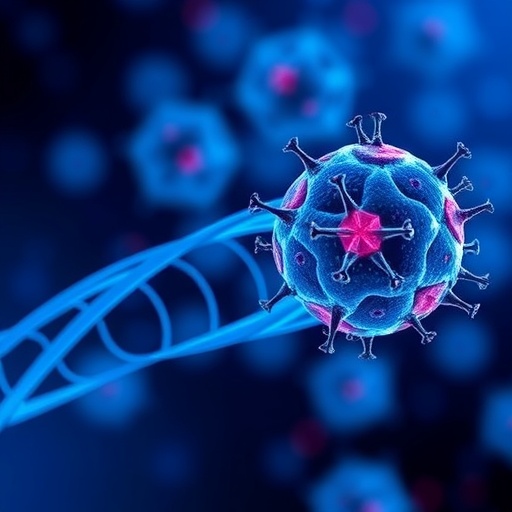In the complex and hostile microenvironment of tumors, the immune cells charged with combating cancer face a barrage of challenges that severely impair their function. Among the most critical and less understood factors are the metabolic and structural stresses inflicted upon these immune warriors, particularly T cells. Recent groundbreaking research from the University of Pittsburgh offers a pioneering glimpse into one such mechanism: how oxidative damage to telomeres—protective structures at the ends of chromosomes—triggers T cell dysfunction, thereby compromising immune responses against cancer.
Tumors create a milieu rife with hypoxia (low oxygen), acidity, nutrient deprivation, and molecular toxins, all of which converge to strain the mitochondria within T cells. Mitochondria, colloquially known as the cell’s powerhouses, are responsible for generating the energy required to carry out immune functions. Under tumor-induced stress, mitochondrial dysfunction occurs, leading to the excessive production of reactive oxygen species (ROS). These ROS are chemically reactive molecules that, at high levels, can inflict severe damage on cellular components including DNA, proteins, and lipids.
The new study, published in the esteemed journal Immunity, illuminates a critical link between mitochondrial ROS generation and telomeric damage in T cells. Normally, telomeres serve as protective caps at chromosome ends, preventing genomic instability and cellular aging. However, the research team discovered that ROS generated by dysfunctional mitochondria migrate into the nucleus and preferentially damage telomeres. This triggered a cascade of cellular signals that push T cells toward exhaustion—a state in which immune cells lose their potency, limiting their ability to attack cancer effectively.
Assistant Professor Dayana Rivadeneira, the study’s lead author, emphasized the therapeutic implications of their findings. By employing a precisely targeted antioxidant that specifically shields telomeres from oxidative damage, they were able to restore T cell functionality in mouse models. “What’s remarkable is that we can intercept the damage process at the telomere level and effectively ‘rescue’ the immune cells,” Rivadeneira explained. This nuanced approach differentiates itself by focusing on telomere stability rather than broadly targeting mitochondrial dysfunction or ROS systemically.
The researchers initially embarked on their investigation with a focus on mitochondrial damage and its influence on T cell performance. Their work unexpectedly expanded into telomere biology through collaboration with experts in molecular pharmacology and chemical biology. Together, they devised a sophisticated genetic mouse model capable of generating controlled amounts of oxidative damage localized only to either mitochondria or telomeres using far-red light activation. This methodological innovation allowed for unprecedented precision in dissecting the crosstalk between cellular powerhouses and the nuclear genome.
Their experiments revealed a fascinating bidirectional communication between mitochondria and telomeres. Damaging mitochondria led to rapid telomeric impairment, and conversely, direct telomere damage sent distress signals back to the mitochondria, effectively instructing the cell to shut down and enter exhaustion. “It illustrates a feedback loop that was previously unappreciated, especially within the immune system,” said senior author Greg Delgoffe. This paradigm-shifting insight reveals telomeres not simply as passive chromosome end-caps but as active participants in regulating cellular energy status and immune cell fate.
At the mechanistic level, the culprit for this vicious cycle appears to be ROS—these reactive molecules that induce oxidative lesions within telomeric DNA. The research team hypothesized that neutralizing ROS specifically at telomeres could break the degenerative loop and preserve T cell efficacy. They engineered a fusion protein combining an antioxidant enzyme with a telomere-binding protein that tethers the protective agent directly at the chromosome ends. This clever molecular design ensured that antioxidant activity was localized precisely where the damage occurs.
When these modified T cells were introduced into mice bearing aggressive melanoma tumors, the results were dramatic. Compared to unmodified T cells, the telomere-antioxidant-protected cells showcased significantly improved survival rates and curtailed tumor growth. This strongly supports the notion that telomere-specific antioxidative strategies can reinvigorate exhausted T cells and bolster anti-tumor immunity. Such findings pave the way for integrating this approach into existing immunotherapeutic modalities.
One particularly promising application is in the realm of chimeric antigen receptor T cell (CAR-T) therapy, a rapidly advancing cancer treatment that involves genetically engineering a patient’s own T cells to target tumors more aggressively. “By incorporating telomere protection into the CAR-T cell production pipeline, we can enhance their durability and potency within the hostile tumor microenvironment,” Delgoffe said. This dual genetic engineering may substantially improve patient outcomes by creating T cells resistant to the common pitfalls imposed by oxidative stress.
Looking forward, Rivadeneira’s laboratory is developing protocols to apply telomere-specific antioxidant strategies to human T cells, inching closer to clinical translation. The potential to amplify and sustain T cell function in cancer patients could revolutionize immunotherapy approaches. Furthermore, her lab plans to explore the broader implications of telomere health on systemic immunity and cancer progression, including how conventional treatments like chemotherapy might inadvertently impair immune resilience by damaging telomeres.
Understanding the interplay between chemotherapy-induced telomere damage and immune cell exhaustion may also explain variability in patient responses to immunotherapies. If chemotherapy diminishes T cell function via telomeric instability, adjunct treatments focusing on telomere maintenance might substantially improve therapeutic efficacy. The implications of this line of research extend beyond oncology, potentially influencing how we approach immune aging and chronic immune deficiencies at large.
This comprehensive study situates telomere integrity at the heart of immune cell endurance within tumors. By illuminating the previously underappreciated molecular dialogue between mitochondria and telomeres mediated by oxidative stress, it opens new frontiers for targeted therapeutic interventions. The capacity to protect T cells against telomeric damage offers a fresh vantage point to bolster immune function where it matters most—with profound implications for cancer treatment and beyond.
Subject of Research: T cell dysfunction in cancer driven by oxidative stress-induced telomere damage
Article Title: Oxidative-stress-induced telomere instability drives T cell dysfunction in cancer
News Publication Date: 9-Sep-2025
Web References: https://www.sciencedirect.com/science/article/pii/S1074761325003711
References: DOI 10.1016/j.immuni.2025.08.008
Image Credits: Rivadeneira et al. (2025) Immunity
Keywords: Telomeres, Immunotherapy, Cancer, Immunology, T cell deficiency, Mitochondria, DNA damage, DNA, Antioxidants




